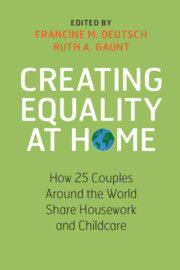Book contents
- Creating Equality at Home
- Advance Praise for Creating Equality at Home
- Creating Equality at Home
- Copyright page
- Dedication
- Contents
- Contributors
- Acknowledgments
- Development and Gender Equality in Participating Countries
- Setting the Stage
- 1 Introduction
- 2 Past and Current Research
- Consciously Creating Equality
- Violating Social Norms
- Prioritizing Family
- Drawing on Lessons from Families of Origin
- Using Government Policies
- What We Have Learned
- Index
- References
1 - Introduction
from Setting the Stage
Published online by Cambridge University Press: 03 June 2020
- Creating Equality at Home
- Advance Praise for Creating Equality at Home
- Creating Equality at Home
- Copyright page
- Dedication
- Contents
- Contributors
- Acknowledgments
- Development and Gender Equality in Participating Countries
- Setting the Stage
- 1 Introduction
- 2 Past and Current Research
- Consciously Creating Equality
- Violating Social Norms
- Prioritizing Family
- Drawing on Lessons from Families of Origin
- Using Government Policies
- What We Have Learned
- Index
- References
Summary
This introductory chapter describes how Creating Equality at Home differs from other books/articles on the division of domestic labor. It reviews the major changes in the public sphere that are decreasing the gender gap in legal, political, and social rights favoring men, but documents that in the private sphere of the home, everywhere on earth, on average, women still do a disproportionate share of domestic labor. Nonetheless, the chapter highlights that there are gender resisters today around the world who equally share domestic labor, even in countries that are not friendly to gender equality. Equality in domestic labor is important because it undermines the gender system that disadvantages women, and because it enables the development of key human capacities in both men and women. The chapter introduces the in-depth study of 25 couples in 22 countries around the world. It lays out the organization of each chapter, including the description of couples’ everyday lives, the history of their relationship, and an analysis of the factors that facilitate their equality. It also states the organization of the book, designed to draw attention to the cross-cultural similarities in the creation of equally sharing families.
- Type
- Chapter
- Information
- Creating Equality at HomeHow 25 Couples around the World Share Housework and Childcare, pp. 1 - 7Publisher: Cambridge University PressPrint publication year: 2020



